by Emma Sweeney and Lisa Soverall
Records show that between the 15th and early 19th centuries the River Thames in London was able to freeze over completely. This only happened on average about one year in ten and London’s inhabitants saw it as a great excuse for a party. But why doesn’t the Thames Freeze any more?
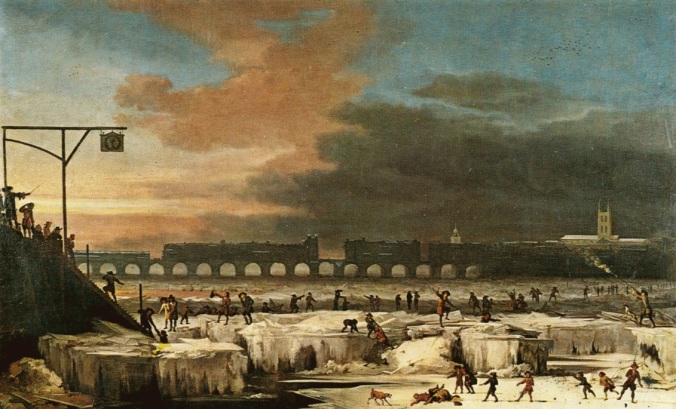
A view of the old London Bridge in 1677 by Abraham Hondius
In addition to changes to the climate, there were several factors that contributed to the freezing of the Thames. Firstly, as ice blocks formed and floated down the river they would become wedged in the arches of the old London Bridge (shown above). The spacing was much narrower than in later versions of the bridge. This blockage would then cause the flow of the river to slow and freeze more easily.
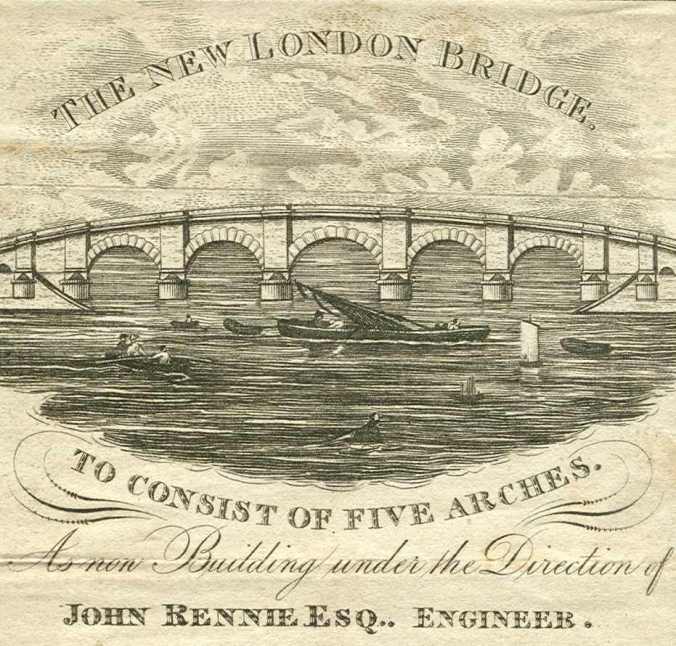
The new bridge, built in 1831 had much wider arches
Another factor to consider is that the stretch of the Thames that flows through London was wider, shallower and therefore slower than today. The Victoria and Chelsea embankments, which were built in the 19th century made the river deeper and narrower, increasing the speed of flow and preventing it from freezing. Also, the increased size of London has led to an urban heat island effect, absorbing heat during the day and releasing it at night. This keeps the temperature high.
Finally, the tributaries that fed the Thames, like the Tyburn, the Fleet and Earl’s Sluice in Rotherhithe were all restricted to underground culverts as London developed. This reduced the influx of ice.
So the Frost Fairs are no more, but fortunately we have lots of images and resources in our collections at Southwark local History Library and Archive to show us how this tradition evolved over the Centuries.
1564 – 65
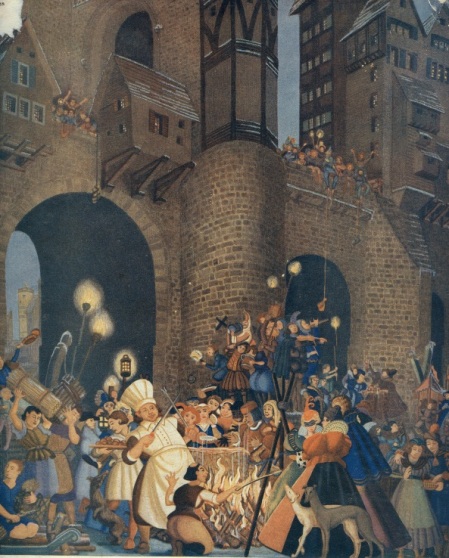
Artist’s impression of festivities under old London Bridge, 1564-65
‘People went over and alongst the Thames on the ise from London Bridge to Westminster. Some plaied at the foot-ball as boldlie there as if it had beene on the drie land’
[Raphael Holinshed]
Contemporary accounts of this winter are difficult to come by. Walter Thornbury gives the following second hand account in Old and New London (1878):
‘A hard frost set in on the 21st of December, 1564. Diversions on the Thames included football and shooting at marks. The courtiers from the Palace of Whitehall mixed with the citizens, and tradition has it that Queen Elizabeth herself walked upon the ice…
…On the night of the 3rd of January however, it began to thaw, and on the 5th there was no ice to be seen on the river.’
1607 – 08
‘The river showed not now, neither shows it yet, like a river, but like a field; where archers shoot at pricks, while others play football. It is a place of mastery where some wrestle and some run…’
[Cold doings at London attributed to Thomas Dekker]
1607–08 saw the first proper frost fair with a tent city on the Thames. In Thomas Dekker’s dialogue Cold doings at London, a citizen of London describes the spectacle to a visiting countryman:
‘Men, women and children walked over and up and down in such companies; that I verily believe and I dare almost swear it, the one half, if not three parts of the people in the city have been seen going on the Thames.’
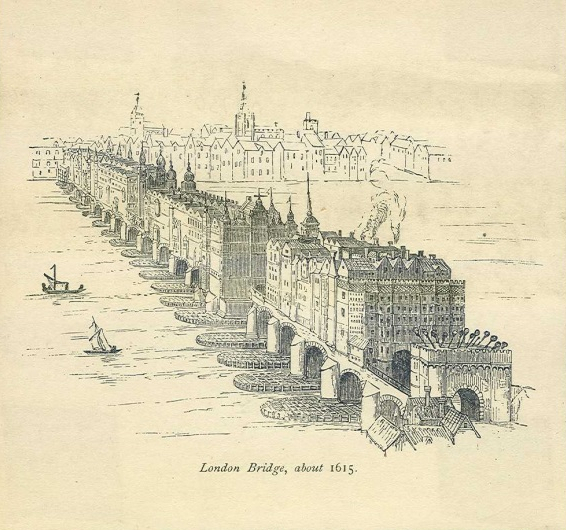
Old London Bridge, c.1610. The narrow arches were easily clogged with ice, allowing the river to freeze over
1683 – 84
‘Behold the wonder of the this present age
A famous river now becomes a stage’
[Anon]
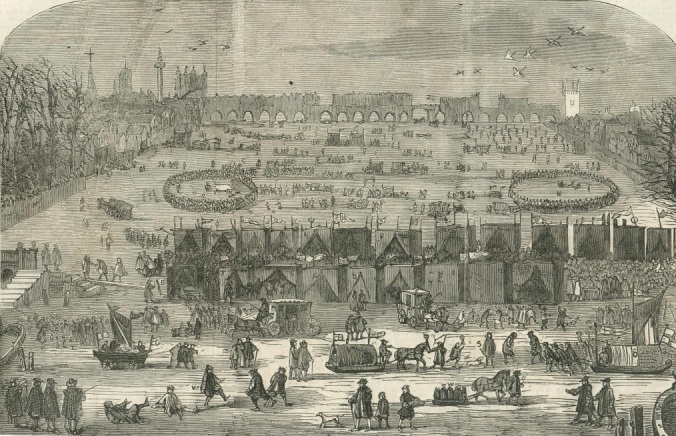
The Thames in full party mode. Can you spot Southwark Cathedral?
London diarist, John Evelyn described the range of amusements on the ice this year:
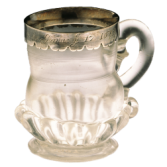 ‘…sleds, sliding with skeetes, a bull-baiting, horse and coach races, puppet plays and interludes, cooks, tipling and other lewd places, so that it seemed to be a bacchanalian triumph, or carnival on the water’
‘…sleds, sliding with skeetes, a bull-baiting, horse and coach races, puppet plays and interludes, cooks, tipling and other lewd places, so that it seemed to be a bacchanalian triumph, or carnival on the water’
Some of the stalls sold souvenirs like this glass and silver mug, possibly made in Southwark
1788 – 89
‘The Silver Thames was frozen o’er,
No difference ‘twixt the stream and shore,
The like no man hath seen before
Except he lived in days of yore’
‘No sooner had the Thames acquired a sufficient consistence that booths, turn-abouts &c. &c. were erected; the puppet shows, wild beast &c., were transported from every adjacent village; whilst the watermen, that they might draw their usual resources from the water broke in the ice close to the shore, and erected bridges, with toll-bars, to make every passenger pay a halfpenny for getting to the ice.’
[The London Chronicle, 1789]
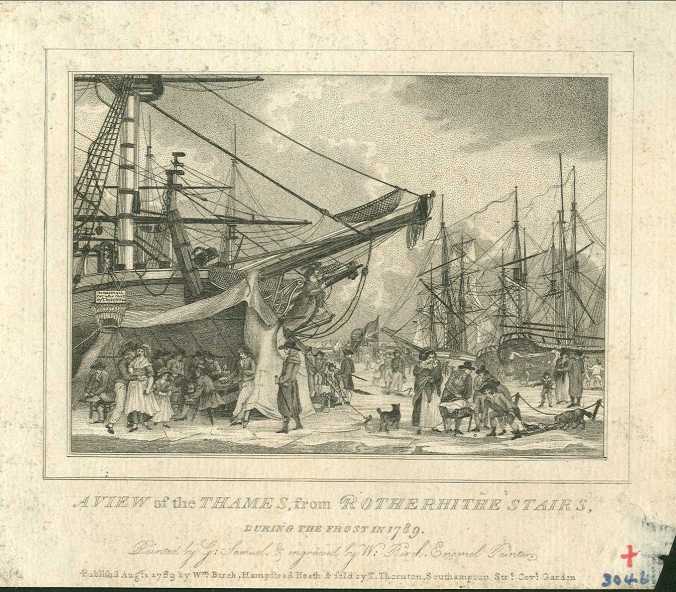
A view of the Thames from Rotherhithe Stairs January 1789 by G. Samuel
1813 – 14: ‘The little ice age’
‘Behold the Thames is frozen o’er,
Which lately Ships of mighty Burthen bore;
Now different Arts and Pastimes here you see,
But PRINTING claims the Superiority.’
[Anon]
Among the array of businesses that operated on the ice this year was the printing trade. Ten printing presses were in operation, turning out crude woodcut illustrations and ballads. The route from Blackfriars to the South bank was named ‘City Road’and at one of the many stalls ‘Lapland Mutton’ was on offer at a shilling a slice.
Charles Dickens, one of Southwark’s most famous residents, is responsible for the popular belief that it should always snow at Christmas thanks to A Christmas Carol. When the story was published in 1843 London was experiencing fairly mild winters, but as he wrote, Dickens was probably recollecting his early childhood in the 1810s, when Britain was experiencing the last of the ‘Little Ice Age.’ Six of his first nine Christmases were white and one of these fell in the winter of 1813-14, when the last Frost Fair was held on the Thames.

It was soon after this last fair that work began on a new London Bridge to allow for easier water flow. The selected design by John Rennie (who had designed both Southwark and Waterloo bridges) was completed by his sons George and John in 1831. The Thames in London has kept on flowing ever since.



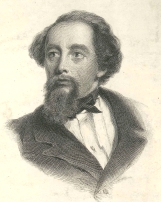 As a journalist in the early 1830s, Dickens would occasionally go out on patrol with the River Police. It was accompanying them that he visited Jacob’s Island and witnessed the poverty and foul stench of Folly Ditch.
As a journalist in the early 1830s, Dickens would occasionally go out on patrol with the River Police. It was accompanying them that he visited Jacob’s Island and witnessed the poverty and foul stench of Folly Ditch.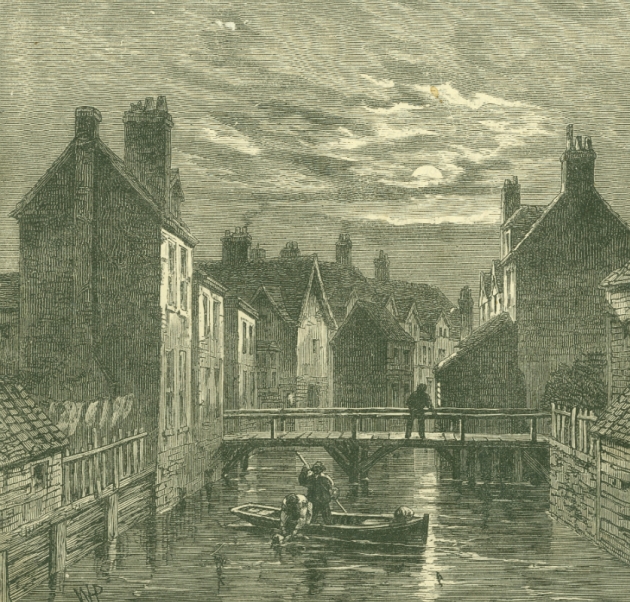


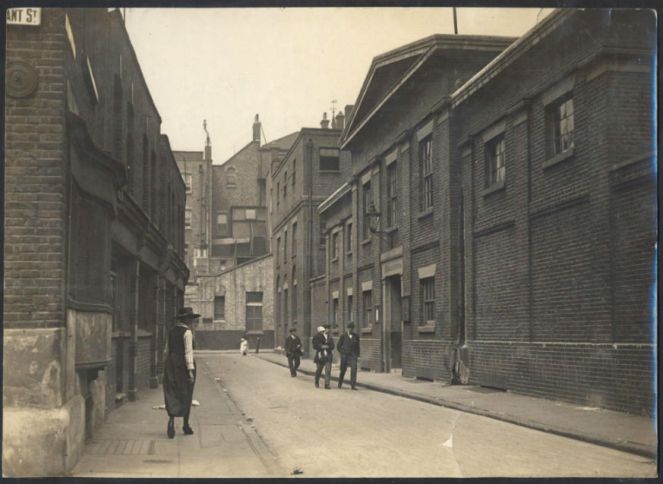
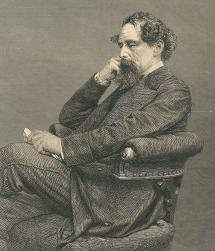 The St. Saviour’s Union Workhouse at Mint Street is thought to have provided Dickens with the model for the scene in
The St. Saviour’s Union Workhouse at Mint Street is thought to have provided Dickens with the model for the scene in  The Lancet investigated conditions in London workhouses and their infirmaries for a series of articles. Their description paints an abysmal picture of life in Mint Street Workhouse:
The Lancet investigated conditions in London workhouses and their infirmaries for a series of articles. Their description paints an abysmal picture of life in Mint Street Workhouse: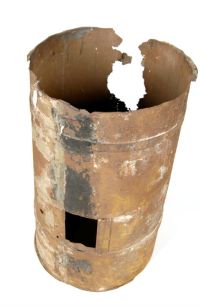 The pot, or ‘copper’ from the workhouse was donated to the Cuming Museum by the Workhouse Board of Guardians in 1921. It stood in the corner of the large stone hall at the workhouse and the broth or gruel was ladled out to hungry inmates. A circular brick wall around the base held in the fire, but was damaged when the museum was hit by a bomb during the Second World War.
The pot, or ‘copper’ from the workhouse was donated to the Cuming Museum by the Workhouse Board of Guardians in 1921. It stood in the corner of the large stone hall at the workhouse and the broth or gruel was ladled out to hungry inmates. A circular brick wall around the base held in the fire, but was damaged when the museum was hit by a bomb during the Second World War.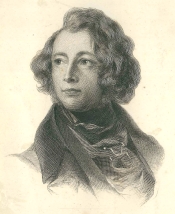 Charles Dickens first came to Southwark at the age of 12, when his parents and all the Dickens children except for Charles and his sister Fanny, were imprisoned at Marshalsea Debtors Prison for a £40 and 10 shillings debt owed to a local baker. Charles moved to nearby Lant street to be close to his family in the prison. His experiences of poverty as a child strongly influenced his writing and are found in descriptions and characters in many of his novels. He described many places in Southwark which he had known as a child and some are still recognisable today.
Charles Dickens first came to Southwark at the age of 12, when his parents and all the Dickens children except for Charles and his sister Fanny, were imprisoned at Marshalsea Debtors Prison for a £40 and 10 shillings debt owed to a local baker. Charles moved to nearby Lant street to be close to his family in the prison. His experiences of poverty as a child strongly influenced his writing and are found in descriptions and characters in many of his novels. He described many places in Southwark which he had known as a child and some are still recognisable today.


 The museum’s collection also includes a key to Marshalsea prison with a label attached which reads: “The key of Marshalsea Prison. Given to S. W. by her father 1884. Where little Dorrit was born. Written by Charles Dickens.”
The museum’s collection also includes a key to Marshalsea prison with a label attached which reads: “The key of Marshalsea Prison. Given to S. W. by her father 1884. Where little Dorrit was born. Written by Charles Dickens.”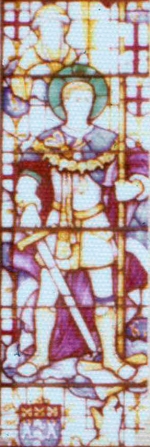 Little Dorrit, one of Dickens characters from a
Little Dorrit, one of Dickens characters from a 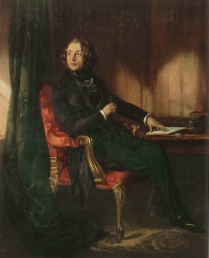 Charles Dickens has a long and deep association with Southwark, both personal and literary, and particularly with the area known as the Borough.
Charles Dickens has a long and deep association with Southwark, both personal and literary, and particularly with the area known as the Borough.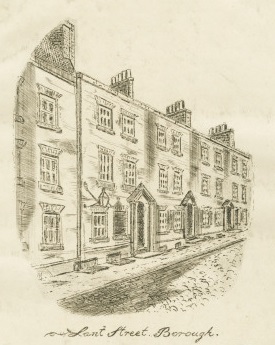 Poor Charles was left to lodge alone, at the age of just 12 years old, in nearby Lant Street. And this is where his long and deep association with Southwark, both personal and literary, began.
Poor Charles was left to lodge alone, at the age of just 12 years old, in nearby Lant Street. And this is where his long and deep association with Southwark, both personal and literary, began.